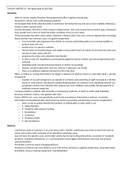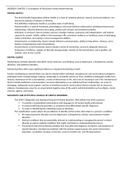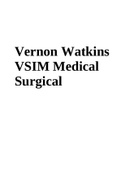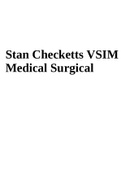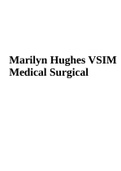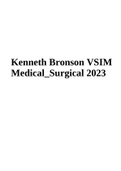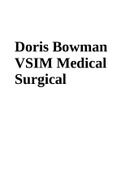Lone Star College
Latest uploads at Lone Star College. Looking for notes at Lone Star College? We have lots of notes, study guides and study notes available for your school.
-
344
-
1
-
25
All courses for Lone Star College
- RNSG 1137 RNSG1137 5
- RNSG 1251 2
- RNSG 1261 RNSG1261 10
- RNSG 1261 Medical-Surgical Nursing RNSG1261 2
- RNSG 1261 Medical-Surgical Nursing / HESI Patient Review RNSG1261 2
- RNSG 1261 Medical-Surgical Nursing / HESI Patient Review (RNSG1261 RNSG1261 2
- RNSG 1261 Medical-Surgical Nursing/ Pre-Quiz Fundamentals: Scenario 8 – Maurice A RNSG1261 1
- RNSG 1261/ Scenario 2 – Alcohol Withdrawal/Aggression Robert Jackson 1
- RNSG 1261/ Scenario 2 – Alcohol Withdrawal/Aggression Robert Jackson 2
- RNSG 2213 RNSG 2213 1
- RNSG 631A 2
- RNSG VNSG 1201 3
- RSPT 2414 RSPT2414 1
Latest notes & summaries Lone Star College
Dementia refers to various organic disorders that progressively affect cognitive functioning. Dementia is chronic and usually develops gradually Most people think of AD when dementia is mentioned, but dementia may also occur more suddenly following a stroke or other vascular event vascular dementia, this form is often related to hypertension, and is the second most common type of dementia many people have a form of mixed dementia consisting of two or more types Of the dem...
MENTAL HEALTH The World Health Organization defines health as a state of complete physical, mental, and social wellness, not merely the absence of disease or infirmity. This definition emphasizes health as a positive state of well-being Mental health is a state of emotional, psychological, and social wellness evidenced by satisfying interpersonal relationships, effective behavior and coping, positive self-concept, and emotional stability. Individual, or personal, factors include...
Vernon Watkins VSIM. A patient handoff was performed. Postoperative patients are at risk for complications such as atelectasis, pneumonia, deep vein thrombosis, pulmonary embolism, constipation, paralytic ileus, and wound infection. This patient's pulmonary embolism (PE) is most likely the result of deep vein thrombosis related to surgery and decreased mobility. PE is a life-threatening medical emergency. Signs and symptoms range from dyspnea, pleuritic chest pain, and tachynpnea to ...
Stan Checketts VSIM. A patient handoff was performed. Vomiting results in a loss of hydrogen ions and potassium from the stomach, leading to a reduction of chlorides and potassium in the blood and to metabolic alkalosis. Dehydration and acidosis develop from loss of water and sodium. With acute fluid losses, severe hypovolemia and hypovolemic shock may occur, and fluid resuscitation is critical. Treatment of metabolic alkalosis is aimed at reversing the underlying disorder (small bowel ob...
RNSG 1261 - Marilyn Hughes VSIM Medical Surgical Nursing. A potential complication of fracture, compartment syndrome in an extremity is a limb-threatening condition that occurs when perfusion pressure falls below tissue pressure within a closed anatomic compartment. Without prompt intervention, the decrease in blood flow to tissues results in ischemia. Frequent assessment of neurovascular function after fracture is essential. Sensory deficits, such as paresthesia (burning or tingling sensa...
RNSG 1261 - Medical-Surgical Nursing | Kenneth Bronson VSIM. Anaphylactic reactions may be triggered by medications. Symptoms range from flushing, warmth, urticaria, anxiety, itching, cough, and wheezing, to severe systemic reactions, such as severe bronchospasm, laryngeal edema, acute dyspnea, cyanosis, and hypotension. Dysphagia, abdominal cramping, vomiting, diarrhea, and seizures with cardiac arrest and coma may follow. Early recognition and withdrawal of the triggering substance is pi...
RNSG 1261 - Doris Bowman VSIM Medical Surgical Nursing. Nursing management objectives for the patient in the post anesthesia care unit are to provide care until the patient has recovered from the effects of anesthesia, is oriented, has stable vital signs, and shows no evidence of complications. Pain control is a critical component of postoperative care and often includes IV opioid analgesic medications to provide immediate but short-acting pain relief. The most common adverse effects of op...
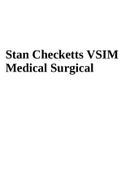
RNSG 1261: Stan Checketts VSIM | Medical Surgical (2023) You placed a nasal oxygen cannula. This was part of your orders. 10:49 You turned the oxygen on. 11:10 Patient status - ECG: Sinus tachycardia. Heart rate: 122. Pulse: Present. Blood pressure: 107/76 mm Hg. Respiration: 28. Conscious state: Appropriate. SpO2: 91%. Temp: 99 F (37 C) 11:21 You asked the patient if he felt nauseated. He replied: 'Yes, a little.' 11:34 You phoned the provider in order to discuss the patient.
- Package deal
- Exam (elaborations)
- • 5 pages's •
RNSG 1261: Stan Checketts VSIM | Medical Surgical (2023) You placed a nasal oxygen cannula. This was part of your orders. 10:49 You turned the oxygen on. 11:10 Patient status - ECG: Sinus tachycardia. Heart rate: 122. Pulse: Present. Blood pressure: 107/76 mm Hg. Respiration: 28. Conscious state: Appropriate. SpO2: 91%. Temp: 99 F (37 C) 11:21 You asked the patient if he felt nauseated. He replied: 'Yes, a little.' 11:34 You phoned the provider in order to discuss the patient.

RNSG 1261; Vernon Watkins VSIM Medical Surgical Nursing (2023) You took a venous blood sample. This is reasonable. 15:08 You provided patient education. 15:10 Patient status - ECG: Sinus tachycardia with signs of pulmonary hypertension. Heart rate: 112. Pulse: Present. Blood pressure: 152/91 mm Hg. Respiration: 24. Conscious state: Appropriate. SpO2: 91%. Temp: 99 F (37 C) 15:39 You asked the patient how he felt. He replied: 'Not too good.' 15:45 You asked the patient if he had any diff...
- Package deal
- Exam (elaborations)
- • 5 pages's •
RNSG 1261; Vernon Watkins VSIM Medical Surgical Nursing (2023) You took a venous blood sample. This is reasonable. 15:08 You provided patient education. 15:10 Patient status - ECG: Sinus tachycardia with signs of pulmonary hypertension. Heart rate: 112. Pulse: Present. Blood pressure: 152/91 mm Hg. Respiration: 24. Conscious state: Appropriate. SpO2: 91%. Temp: 99 F (37 C) 15:39 You asked the patient how he felt. He replied: 'Not too good.' 15:45 You asked the patient if he had any diff...
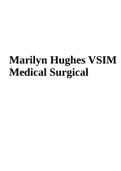
Marilyn Hughes VSIM Medical Surgical (RNSG 1261) You asked the patient if she could feel her toes. She replied: 'My left foot feels really numb.' 9:57 A patient handoff was performed. A potential complication of fracture, compartment syndrome in an extremity is a limb-threatening condition that occurs when perfusion pressure falls below tissue pressure within a closed anatomic compartment. Without prompt intervention, the decrease in blood flow to tissues results in ischemia. Frequent a...
- Package deal
- Exam (elaborations)
- • 4 pages's •
Marilyn Hughes VSIM Medical Surgical (RNSG 1261) You asked the patient if she could feel her toes. She replied: 'My left foot feels really numb.' 9:57 A patient handoff was performed. A potential complication of fracture, compartment syndrome in an extremity is a limb-threatening condition that occurs when perfusion pressure falls below tissue pressure within a closed anatomic compartment. Without prompt intervention, the decrease in blood flow to tissues results in ischemia. Frequent a...

